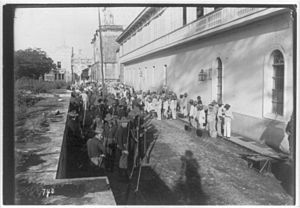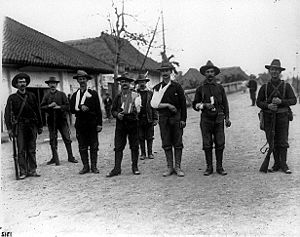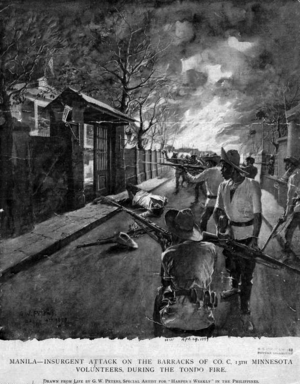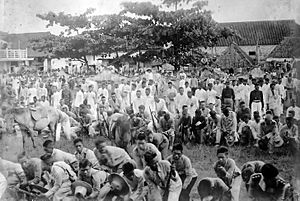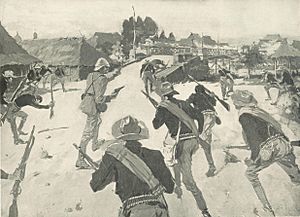Philippine–American War facts for kids
Quick facts for kids Philippine American WarDigmaang Pilipino–Amerikano |
|||||||||
|---|---|---|---|---|---|---|---|---|---|
| Part of Decolonisation of Asia | |||||||||
  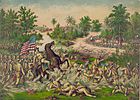  Clockwise from top left: U.S. troops in Manila, Gregorio del Pilar and his troops around 1898, Americans guarding the Pasig River bridge in 1898, the Battle of Santa Cruz (1899) |
|||||||||
|
|||||||||
| Belligerents | |||||||||
|
1899–1902:
|
1899–1902:
|
||||||||
|
1902–1913:
|
1902–1906: 1899–1905: 1899–1913: |
||||||||
| Commanders and leaders | |||||||||
|
|
||||||||
| Units involved | |||||||||
|
1899–1902:
1902–1913:
|
1899–1902:
1902–1913 |
||||||||
| Strength | |||||||||
|
≈80,000–100,000 regular and irregular |
||||||||
| Casualties and losses | |||||||||
| 4,200 killed, 2,818 wounded, several succumbed to disease | About 10,000 killed (Emilio Aguinaldo estimate), 16,000–20,000 killed (American estimate) |
||||||||
| Filipino civilians: 200,000–250,000 died | |||||||||
The Philippine–American War, known alternatively as the Philippine Insurrection, Filipino–American War, or Tagalog Insurgency, was fought between the First Philippine Republic and the United States from February 4, 1899, until July 2, 1902. Tensions arose after the United States annexed the Philippines under the Treaty of Paris at the conclusion of the Spanish–American War rather than acknowledging the Philippines' declaration of independence, developing into the eruption of open battle. The war can be seen as a continuation of the Philippine struggle for independence that began in 1896 with the Philippine Revolution against Spanish rule.
Fighting between the forces of the United States and the forces of the Philippine Republic broke out on February 4, 1899, in what became known as the 1899 Battle of Manila. On June 2, 1899, the First Philippine Republic officially declared war against the United States. The Philippine President Emilio Aguinaldo was captured on March 23, 1901, and the war was officially declared ended by the American government on July 2, 1902, with a victory for the United States. However, some Philippine groups—some led by veterans of the Katipunan, a Philippine revolutionary society that had launched the revolution against Spain—continued to battle the American forces for several more years. Among those leaders was Macario Sakay, a veteran Katipunan member who established (or re-established) the Tagalog Republic in 1902 along Katipunan lines in contrast to Aguinaldo's Republic, with himself as president. Other groups, including the Muslim Moro peoples of the southern Philippines and quasi-Catholic Pulahan religious movements, continued hostilities in remote areas. The resistance in the Moro-dominated provinces in the south, called the Moro Rebellion by the Americans, ended with their final defeat at the Battle of Bud Bagsak on June 15, 1913.
The war resulted in at least 200,000 Filipino civilian deaths, mostly due to diseases such as cholera and to famine. Some estimates for total civilian dead reach up to a million. The war and subsequent occupation by the U.S. changed the culture of the islands, leading to the rise of Protestantism and disestablishment of the Catholic Church and the introduction of English to the islands as the primary language of government, education, business, and industry.
In 1902, the United States Congress passed the Philippine Organic Act, which provided for the creation of the Philippine Assembly, with members to be elected by Filipino males (women did not have the right to vote until a 1937 plebiscite). This act was superseded by the 1916 Jones Act (Philippine Autonomy Act), which contained the first formal and official declaration of the United States government's commitment to eventually grant independence to the Philippines. The 1934 Tydings–McDuffie Act (Philippine Independence Act) created the Commonwealth of the Philippines the following year, increasing self-governance, and established a process towards full independence (originally scheduled for 1944, but delayed by World War II and the Japanese occupation of the Philippines). The United States eventually granted full Philippine independence in 1946 through the Treaty of Manila.
Background
Philippine Revolution
Andrés Bonifacio was a warehouseman and clerk from Manila. On July 7, 1892, he established the Katipunan—a revolutionary organization formed to gain independence from Spanish colonial rule by armed revolt. In August 1896, the Katipunan was discovered by the Spanish authorities and thus launched its revolution. Fighters in Cavite province won early victories. One of the most influential and popular leaders from Cavite was Emilio Aguinaldo, mayor of Cavite El Viejo (modern-day Kawit), who gained control of much of the eastern portion of Cavite province. Eventually, Aguinaldo and his faction gained control of the leadership of the Philippine revolution. After Aguinaldo was elected president of a revolutionary government superseding the Katipunan at the Tejeros Convention on March 22, 1897, his government had Bonifacio executed for treason after a show trial on May 10, 1897.
Aguinaldo's exile and return

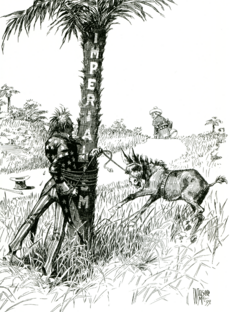
By late 1897, after a succession of defeats for the revolutionary forces, the Spanish had regained control over most of the Philippine territory the rebels had taken. Aguinaldo and Spanish Governor-General Fernando Primo de Rivera entered into armistice negotiations while Spanish forces surrounded Aguinaldo's hideout and base in Biak-na-Bato in Bulacan province, and Aguinaldo reorganized his "Republic of the Philippines" in the meantime. On December 14, 1897, an agreement was reached in which the Spanish colonial government would pay Aguinaldo $MXN800,000 in Manila—in three installments if Aguinaldo would go into exile outside of the Philippines.
Upon receiving the first of the installments, Aguinaldo and 25 of his closest associates left their headquarters at Biak-na-Bato and made their way to Hong Kong, according to the terms of the agreement. Before his departure, Aguinaldo denounced the Philippine Revolution, exhorted Filipino rebel combatants to disarm, and declared those who continued hostilities and waging war to be bandits. Despite Aguinaldo's denunciation, some of the revolutionaries continued their armed revolt against the Spanish colonial government. According to Aguinaldo, the Spanish never paid the second and third installments of the agreed-upon sum.
On April 22, 1898, while in exile, Aguinaldo had a private meeting in Singapore with United States Consul E. Spencer Pratt, after which he decided to again take up the mantle of leadership in the Philippine Revolution. According to Aguinaldo, Pratt had communicated with Commodore George Dewey (commander of the Asiatic Squadron of the United States Navy) by telegram, and passed assurances from Dewey to Aguinaldo that the United States would recognize the independence of the Philippines under the protection of the United States Navy. Pratt reportedly stated that there was no necessity for entering into a formal written agreement because the word of the Admiral and of the United States Consul were equivalent to the official word of the United States government. With these assurances, Aguinaldo agreed to return to the Philippines.
Pratt later contested Aguinaldo's account of these events, and denied any "dealings of a political character" with the leader. Admiral Dewey also refuted Aguinaldo's account, stating that he had promised nothing regarding the future:
From my observation of Aguinaldo and his advisers I decided that it would be unwise to co-operate with him or his adherents in an official manner. ... In short, my policy was to avoid any entangling alliance with the insurgents, while I appreciated that, pending the arrival of our troops, they might be of service.
Filipino historian Teodoro Agoncillo writes of "American apostasy", saying that it was the Americans who first approached Aguinaldo in Hong Kong and Singapore to persuade him to cooperate with Dewey in wresting power from the Spanish. Conceding that Dewey may not have promised Aguinaldo American recognition and Philippine independence (Dewey had no authority to make such promises), he writes that Dewey and Aguinaldo had an informal alliance to fight a common enemy, that Dewey breached that alliance by making secret arrangements for a Spanish surrender to American forces, and that he treated Aguinaldo badly after the surrender was secured. Agoncillo concludes that the American attitude towards Aguinaldo "... showed that they came to the Philippines not as a friend, but as an enemy masking as a friend."
After four months in exile, Aguinaldo decided to resume his role in the Philippine Revolution. He departed from Singapore aboard the steamship Malacca on April 27, 1898. He arrived in Hong Kong on May 1, the day that US Commodore George Dewey's naval forces destroyed Rear-Admiral Patricio Montojo's Spanish Pacific Squadron at the Battle of Manila Bay. Aguinaldo departed Hong Kong aboard the USRC McCulloch on May 17, arriving in Cavite on May 19.
Less than three months after Aguinaldo's return, the Philippine Revolutionary Army had conquered nearly all of the Philippines. With the exception of Manila, which was surrounded by revolutionary forces some 12,000 strong, the Filipinos controlled the Philippines. Aguinaldo turned over 15,000 Spanish prisoners to the Americans, offering them valuable intelligence. Aguinaldo declared independence at his house in Cavite El Viejo on June 12, 1898.
The Philippine Declaration of Independence was not recognized by either the United States or Spain, and the Spanish government ceded the Philippines to the United States in the 1898 Treaty of Paris, which was signed on December 10, 1898, in consideration for an indemnity for Spanish expenses and assets lost.
Upon his return in May 1898, Aguinaldo established a "Dictatorial Government" with himself as "Dictator", under which Philippine independence was declared. About a month later, he established a "Revolutionary Government" in its place and retook the title of "President". He then organized a congress in Malolos, Bulacan to draft a constitution. This led to the formal establishment of the "Philippine Republic" by late January 1899. This government was later known as the First Philippine Republic, as the current Republic of the Philippines considers itself the fifth, and also as the "Malolos Republic" after its capital. Aguinaldo, who had again been re-established as president (by the Malolos congress) on January 1, is today officially considered as "the first President of the Republic of the Philippines" by the Philippine government based on his tenure for the First Republic.
Origins of the conflict
Battle of Manila
On July 9, General Anderson informed Major General Henry Clark Corbin, the Adjutant General of the U.S. Army, that Aguinaldo "has declared himself Dictator and President, and is trying to take Manila without our assistance", opining that that would not be probable but, if done, would allow him to antagonize any U.S. attempt to establish a provisional government. On July 15, Aguinaldo issued three organic decrees assuming civil authority of the Philippines.
On July 18, General Anderson wrote that he suspected Aguinaldo to be secretly negotiating with the Spanish authorities. In a July 21 letter to the Adjutant General, General Anderson wrote that Aguinaldo had "put in operation an elaborate system of military government, under his assumed authority as Dictator, and has prohibited any supplies being given us, except by his order", and that Anderson had written to Aguinaldo that the requisitions on the country for necessary items must be filled, and that he must aid in having them filled.
On July 24, Aguinaldo wrote a letter to General Anderson in effect warning him not to disembark American troops in places conquered by the Filipinos from the Spaniards without first communicating in writing the places to be occupied and the object of the occupation. Murat Halstead, official historian of the Philippine Expedition, writes that General Merritt remarked shortly after his arrival on June 25,
As General Aguinaldo did not visit me on my arrival, nor offer his services as a subordinate military leader, and as my instructions from the President fully contemplated the occupation of the islands by the American land forces, and stated that 'the powers of the military occupant are absolute and supreme and immediately operate upon the political condition of the inhabitants,' I did not consider it wise to hold any direct communication with the insurgent leader until I should be in possession of the city of Manila, especially as I would not until then be in a position to issue a proclamation and enforce my authority, in the event that his pretensions should clash with my designs.
U.S. commanders suspected that Aguinaldo and his forces were informing the Spanish of American movements. U.S. Army Major John R. M. Taylor later wrote, after translating and analyzing insurgent documents,
The officers of the United States Army who believed that the insurgents were informing the Spaniards of the American movements were right.
The secret agreement made by Commodore Dewey and Brigadier General Wesley Merritt with newly arrived Spanish Governor-General Fermín Jáudenes and with his predecessor Basilio Augustín was for the Spanish forces to surrender only to the Americans, not to the Filipino revolutionaries. To save face, the Spanish surrender would take place after a mock battle in Manila which the Spanish would lose; the Filipinos would not be allowed to enter the city. On the eve of the battle, Brigadier General Thomas M. Anderson telegraphed Aguinaldo, "Do not let your troops enter Manila without the permission of the American commander. On this side of the Pasig River you will be under fire." On August 13, American forces captured the city of Manila from the Spanish.
Before the attack on Manila, American and Filipino forces had been allies against Spain in all but name. After the capture of Manila, Spanish and Americans were in a partnership that excluded the Filipino insurgents. Fighting between American and Filipino troops had almost broken out as the former moved in to dislodge the latter from strategic positions around Manila on the eve of the attack. Aguinaldo had been told bluntly by the Americans that his army could not participate and would be fired upon if it crossed into the city. The insurgents were infuriated at being denied triumphant entry into their own capital, but Aguinaldo bided his time. Relations continued to deteriorate, however, as it became clear to Filipinos that the Americans were in the islands to stay.
End of the Spanish–American War
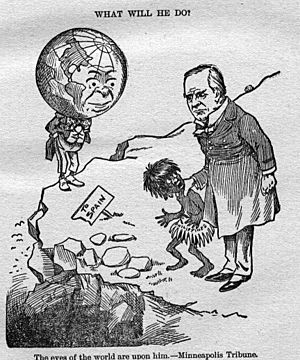
On August 12, 1898, The New York Times reported that a peace protocol had been signed in Washington that afternoon between the U.S. and Spain, suspending hostilities between the two nations. The full text of the protocol was not made public until November 5, but Article III read: "The United States will occupy and hold the City, Bay, and Harbor of Manila, pending the conclusion of a treaty of peace, which shall determine the control, disposition, and government of the Philippines." After conclusion of this agreement, U.S. President McKinley proclaimed a suspension of hostilities with Spain.
Elections were held by the Revolutionary Government between June and September 10, resulting in the seating of a legislature known as the Malolos Congress. In a session between September 15 and November 13, 1898, the Malolos Constitution was adopted. It was promulgated on January 21, 1899, creating the First Philippine Republic with Emilio Aguinaldo as president.
Article V of the peace protocol signed on August 12 had mandated negotiations to conclude a treaty of peace to begin in Paris not later than October 1, 1898. President McKinley sent a five-man commission, initially instructed to demand no more than Luzon, Guam, and Puerto Rico; which would have provided a limited U.S. empire of pinpoint colonies to support a global fleet and provide communication links. In Paris, the commission was besieged with advice, particularly from American generals and European diplomats, to demand the entire Philippine archipelago. The unanimous recommendation was that "it would certainly be cheaper and more humane to take the entire Philippines than to keep only part of it." On October 28, 1898, McKinley wired the commission that "cessation of Luzon alone, leaving the rest of the islands subject to Spanish rule, or to be the subject of future contention, cannot be justified on political, commercial, or humanitarian grounds. The cessation must be the whole archipelago or none. The latter is wholly inadmissible, and the former must therefore be required." The Spanish negotiators were furious over the "immodist demands of a conqueror", but their wounded pride was assuaged by an offer of twenty million dollars for "Spanish improvements" to the islands. The Spaniards capitulated, and on December 10, 1898, the U.S. and Spain signed the Treaty of Paris, formally ending the Spanish–American War. In Article III, Spain ceded the Philippine archipelago to the United States, as follows: "Spain cedes to the United States the archipelago known as the Philippine Islands, and comprehending the islands lying within the following line: [... geographic description elided ...]. The United States will pay to Spain the sum of twenty million dollars ($20,000,000) within three months after the exchange of the ratifications of the present treaty."
In the U.S., there was a movement for Philippine independence; some said that the U.S. had no right to a land where many of the people wanted self-government. In 1898 Andrew Carnegie, an industrialist and steel magnate, offered to pay the U.S. government $20 million to give the Philippines its independence. Those in support of annexation argued against granting the Philippines immediate independence, believing that another colonial power such as the Empire of Japan would have seized the islands if the Americans did not do so.
Benevolent assimilation
On December 21, 1898, President William McKinley issued a proclamation of "benevolent assimilation, substituting the mild sway of justice and right for arbitrary rule" for "the greatest good of the governed". Referring to the Treaty of Paris, it said that "as a result of the victories of American arms, the future control, disposition, and government of the Philippine Islands are ceded to the United States." It enjoined the military commander (General Otis) to make known to the inhabitants of the Philippine Islands that "in succeeding to the sovereignty of Spain" the authority of the United States "is to be exerted for the securing of the persons and property of the people of the islands and for the confirmation of all their private rights and relations." The proclamation specified that "it will be the duty of the commander of the forces of occupation to announce and proclaim in the most public manner that we come, not as invaders or conquerors, but as friends, to protect the natives in their homes, in their employments, and in their personal and religious rights".
The Spanish yielded Iloilo to the insurgents on December 26. An American brigade under General Marcus P. Miller sailed to iloilo on December 26, arriving on the 28th and opening communications with the insurgents. A Filipino official styling himself "Presidente Lopez of the Federal Government of the Visayas", who stated landing required "express orders from the central government of Luzon" refused Miller's force permission to land. News reached Washington from Manila on January 1, 1899, that Miller's forces had been refused permission to land.
Major General Elwell Stephen Otis, who had been appointed Military Governor of the Philippines, had delayed publication of McKinley's proclamation. On January 4, Otis published an amended version edited so as not to convey the meanings of the terms sovereignty, protection, and right of cessation, which were present in the original version. On January 6, 1899, General Otis was quoted in The New York Times as expressing himself as "convinced that the U.S. government intends to seek the establishment of a liberal government, in which the people will be as fully represented as the maintenance of law and order will permit, susceptible of development, on lines of increased representation, and the bestowal of increased powers, into a government as free and independent as is enjoyed by the most favored provinces in the world."
Unknown to Otis, the War Department had also sent an enciphered copy of the Benevolent Assimilation proclamation to General Miller for informational purposes. Miller assumed that it was for distribution and, unaware that a politically bowdlerized version had been published by Otis, published the original in both Spanish and Tagalog translations which eventually made their way to Aguinaldo. Even before Aguinaldo received the unaltered version and observed the changes in the copy he had received from Otis, he was upset that Otis had altered his own title to "Military Governor of the Philippines" from "... in the Philippines". Aguinaldo did not miss the significance of the alteration, which Otis had made without authorization from Washington.
The original proclamation was given by supporters to Aguinaldo who, on January 5, issued a counter-proclamation:
Such procedures, so foreign to the dictates of culture and the usages observed by civilized nations, gave me the right to act without observing the usual rules of intercourse. Nevertheless, in order to be correct to the end, I sent to General Otis commissioners charged to solicit him to desist from his rash enterprise, but they were not listened to.
My government can not remain indifferent in view of such a violent and aggressive seizure of a portion of its territory by a nation which arrogated to itself the title champion of oppressed nations. Thus it is that my government is disposed to open hostilities if the American troops attempt to take forcible possession of the Visayan Islands. I denounce these acts before the world, in order that the conscience of mankind may pronounce its infallable verdict as to who are the true oppressors of nations and the tormentors of human kind.
After some copies of that proclamation had been distributed, Aguinaldo ordered the recall of undistributed copies and issued another proclamation, which was published the same day in El Heraldo de la Revolucion, the official newspaper of the Philippine Republic. There, he said partly,
As in General Otis's proclamation he alluded to some instructions edited by His Excellency the President of the United States, referring to the administration of the matters in the Philippine Islands, I in the name of God, the root and fountain of all justice, and that of all the right which has been visibly granted to me to direct my dear brothers in the difficult work of our regeneration, protest most solemnly against this intrusion of the United States Government on the sovereignty of these islands.
I equally protest in the name of the Filipino people against the said intrusion, because as they have granted their vote of confidence appointing me president of the nation, although I don't consider that I deserve such, therefore I consider it my duty to defend to death its liberty and independence.
Otis, taking these two proclamations as tantamount to war, strengthened American observation posts and alerted his troops. On the other hand, Aguinaldo's proclamations energized the masses with a vigorous determination to fight what was perceived as an ally turned enemy. In the tense atmosphere, some 40,000 Filipinos fled Manila within a period of 15 days.
Meanwhile, Felipe Agoncillo, who had been commissioned by the Philippine Revolutionary Government as Minister Plenipotentiary to negotiate treaties with foreign governments, and who had unsuccessfully sought to be seated at the negotiations between the U.S. and Spain in Paris, was now in Washington. On January 6, he filed a request for an interview with the President to discuss affairs in the Philippines. The next day the government officials were surprised to learn that messages to General Otis to deal mildly with the rebels and not to force a conflict had become known to Agoncillo, and cabled by him to Aguinaldo. At the same time came Aguinaldo's protest against General Otis signing himself "Military Governor of the Philippines".
On January 8, Agoncillo gave out this statement:
In my opinion the Filipino people, whom I represent, will never consent to become a colony dependency of the United States. The soldiers of the Filipino army have pledged their lives that they will not lay down their arms until General Aguinaldo tells them to do so, and they will keep that pledge, I feel confident.
The Filipino committees in London (capital of U.K.), Paris (capital of France) and Madrid (capital of Spain) about this time telegraphed to President McKinley as follows:
We protest against the disembarkation of American troops at Iloilo. The treaty of peace still unratified, the American claim to sovereignty is premature. Pray reconsider the resolution regarding Iloilo. Filipinos wish for the friendship of America and abhor militarism and deceit.
On January 8, Aguinaldo received the following message from Teodoro Sandiko:
To the President of the Revolutionary Government, Malolos, from Sandico, Manila. 8 Jan., 1899, 9.40 p.m..: In consequence of the order of General Rios to his officers, as soon as the Filipino attack begins the Americans should be driven into the Intramuros district and the walled city should be set on fire. Pipi.
The New York Times reported on January 8, that two Americans who had been guarding a waterboat in Iloilo had been attacked, one fatally, and that insurgents were threatening to destroy the business section of the city by fire; and on January 10 that a peaceful solution to the Iloilo issues may result but that Aguinaldo had issued a proclamation threatening to drive the Americans from the islands.
By January 10, insurgents were ready to assume the offensive, but desired, if possible, to provoke the Americans into firing the first shot. They made no secret of their desire for conflict, but increased their hostile demonstrations and pushed their lines forward into forbidden territory. Their attitude is well illustrated by the following extract from a telegram sent by Colonel Cailles to Aguinaldo on January 10, 1899:
Most urgent. An American interpreter has come to tell me to withdraw our forces in Maytubig fifty paces. I shall not draw back a step, and in place of withdrawing, I shall advance a little farther. He brings a letter from his general, in which he speaks to me as a friend. I said that from the day I knew that Maquinley (McKinley) opposed our independence I did not want any dealings with any American. War, war, is what we want. The Americans after this speech went off pale.
Aguinaldo approved the hostile attitude of Cailles, for there is a reply in his handwriting which reads:
I approve and applaud what you have done with the Americans, and zeal and valour always, also my beloved officers and soldiers there. I believe that they are playing us until the arrival of their reinforcements, but I shall send an ultimatum and remain always on the alert.--E. A. Jan. 10, 1899.
On January 31, 1899, the Minister of Interior of the revolutionary First Philippine Republic, Teodoro Sandiko, signed a decree saying that President Aguinaldo had directed that all idle lands be planted to provide food for the people, in view of impending war with the Americans.
War


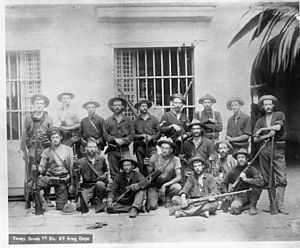
Outbreak of war
On the evening of February 4, Private William W. Grayson—a sentry of the 1st Nebraska Infantry Regiment—fired the first shots of the war at the corner of Sociego and Silencio Streets, in Santa Mesa. According to Grayson's account, they told four Fillipino soldiers to "Halt!" and, when the men responded by cocking their rifles, they fired at them and then retreated. Grayson claimed that he killed a Filipino lieutenant and another Filipino soldier, but neither American nor Filipino official reports mentioned anyone being hit. According to Quennie Ann J. Palafox, writing for the National Historical Commission of the Philippines, two unarmed soldiers were killed. Later that day, Aguinaldo declared "That peace and friendly relations with the Americans be broken and that the latter be treated as enemies, within the limits prescribed by the laws of war." The outbreak of violence triggered the 1899 Battle of Manila. The following day, Filipino General Isidoro Torres came through the lines under a flag of truce to deliver a message from Aguinaldo to General Otis that the fighting had begun accidentally, and that Aguinaldo wished for the hostilities to cease immediately and for the establishment of a neutral zone between the two opposing forces. Otis dismissed these overtures, and replied that the "fighting, having begun, must go on to the grim end". On February 5, General Arthur MacArthur ordered his troops to advance against Filipino troops, beginning a full-scale armed clash. The first Filipino fatality of the war was Corporal Anastacio Felix of the 4th Company, Morong Battalion under Captain Serapio Narváez. The battalion commander was Colonel Luciano San Miguel. On June 2, 1899, the First Philippine Republic issued a declaration of war on the United States, which was publicly proclaimed on that same day by Pedro Paterno, president of the National Assembly.
American war strategy
Annexation of the Philippines by the United States was justified by those in the U.S. government and media in the name of liberating and protecting the peoples in the former Spanish colonies. Senator Albert J. Beveridge, one of the most prominent American imperialists at the time, said: "Americans altruistically went to war with Spain to liberate Cubans, Puerto Ricans, and Filipinos from their tyrannical yoke. If they lingered on too long in the Philippines, it was to protect the Filipinos from European predators waiting in the wings for an American withdrawal and to tutor them in American-style democracy."
On February 11, 1899, one week after the first shots of the war were fired, the city of Iloilo was bombarded by American naval forces from the USS Petrel and the USS Baltimore. Filipino forces set the town on fire before retreating. The city was captured by ground forces led by Brigadier General Marcus Miller, with no loss of American lives. 25 to 30 Filipinos were wounded. The "native" part of the city was almost entirely destroyed.
Months later, after finally securing Manila from the Filipino forces, American forces moved northward, engaging in combat at the brigade and battalion level in pursuit of the fleeing insurgent forces and their commanders. In response to the use of guerrilla warfare tactics by Filipino forces, beginning in September 1899, American military strategy shifted to suppression of the resistance. Tactics became focused on the control of key areas with internment and segregation of the civilian population in "zones of protection" from the guerrilla population. (This is considered to foreshadow the Strategic Hamlet Program that the South Vietnamese government, with U.S. support, used decades later during the Vietnam War). Due to disruption of war and unsanitary conditions, many of the interned civilians died from dysentery.
General Otis gained notoriety for some of his actions in the Philippines. Although his superiors in Washington had directed Otis to avoid military conflict, he did very little to prevent the breakout of war. Otis refused to accept anything but unconditional surrender from the Philippine Army. He often made major military decisions without first consulting leadership in Washington. He acted aggressively in dealing with the Filipinos under the assumption that their resistance would collapse quickly. Even after this assumption proved false, he continued to insist that the insurgency had been defeated, and that the remaining casualties were caused by "isolated bands of outlaws".
Otis also was active in suppressing information about American military tactics from the media. When letters describing American atrocities reached the American media, Otis had each press clipping forwarded to the original writer's commanding officer, who would convince or force the soldier to write a retraction of the original statements.
Filipino war strategy
Estimates of the Filipino forces vary between 80,000 and 100,000, with tens of thousands of auxiliaries. Most of the forces were armed only with bolo knives, bows and arrows, spears and other primitive weapons, which were vastly inferior to the guns and other weapons of the American forces.
A fairly rigid caste system existed in the Philippines during the Spanish colonial era. The goal, or end-state, sought by the First Philippine Republic was a sovereign, independent, stable nation led by an oligarchy composed of members of the educated class (known as the ilustrado class). Local chieftains, landowners, businessmen and cabezas de barangay were the principales who controlled local politics. The war was at its peak when ilustrados, principales, and peasants were unified in opposition to annexation by the United States. The peasants, who represented the majority of the fighting forces, had interests different from their ilustrado leaders and the principales of their villages. Coupled with the ethnic and geographic fragmentation, aligning the interests of people from different social castes was a daunting task. The challenge for Aguinaldo and his generals was to sustain unified Filipino public opposition; this was the revolutionaries' strategic center of gravity.
The Filipino operational center of gravity was the ability to sustain its force of 100,000 irregulars in the field. The Filipino general Francisco Macabulos described the Filipinos' war aim as, "not to vanquish the U.S. Army but to inflict on them constant losses". In the early stages of the war, the Philippine Revolutionary Army employed the conventional military tactics typical of an organized armed resistance. The hope was to inflict enough American casualties to result in McKinley's defeat by William Jennings Bryan in the 1900 presidential election. They hoped that Bryan, who held strong anti-imperialist views, would withdraw the American forces from the Philippines.
McKinley's election victory in 1900 was demoralizing for the insurgents, and convinced many Filipinos that the United States would not depart quickly. Coupled with a series of devastating losses on the battlefield against American forces equipped with superior technology and training, Aguinaldo became convinced that he needed to change his approach. Beginning on September 14, 1899, Aguinaldo accepted the advice of General Gregorio del Pilar and authorized the use of guerrilla warfare tactics in subsequent military operations in Bulacan.
Guerrilla war phase
For most of 1899, the revolutionary leadership had viewed guerrilla warfare strategically only as a tactical option of final recourse, not as a means of operation which better suited their disadvantaged situation. On November 13, 1899, Emilio Aguinaldo decreed that guerrilla war would henceforth be the strategy. This made American occupation of the Philippine archipelago all the more difficult over the next few years. During the first four months of the guerrilla war, the Americans had nearly 500 casualties. The Philippine Army began staging bloody ambushes and raids, such as the guerrilla victories at Paye, Catubig, Makahambus, Pulang Lupa, Balangiga and Mabitac. At first, it seemed that the Filipinos might be able to fight the Americans to a stalemate and force them to withdraw. President McKinley considered withdrawal when the guerrilla raids began.
Martial law
On December 20, 1900, General Arthur MacArthur Jr., who had succeeded Elwell Otis as U.S. Military Governor on May 5, placed the Philippines under martial law, invoking U.S. Army General Order 100. He announced that guerrilla abuses would no longer be tolerated and outlined the rights which would govern the U.S. Army's treatment of guerrillas and civilians. In particular, guerrillas who wore no uniform but peasant dress and shifted from civilian to military status would be held accountable; secret committees that collected revolutionary taxes and those accepting U.S. protection in occupied towns while assisting guerrillas would be treated as "war rebels or war traitors". Filipino leaders who continued to work towards Philippine independence were deported to Guam.
Decline and fall of the First Philippine Republic
The Philippine Army continued suffering defeats from the better armed United States Army during the conventional warfare phase, forcing Aguinaldo to continually change his base of operations throughout the course of the war.
On March 23, 1901, General Frederick Funston and his troops captured Aguinaldo in Palanan, Isabela, with the help of some Filipinos (called the Macabebe Scouts after their home locale) who had joined the Americans' side. The Americans pretended to be captives of the Scouts, who were dressed in Philippine Army uniforms. Once Funston and his "captors" entered Aguinaldo's camp, they immediately fell upon the guards and quickly overwhelmed them and the weary Aguinaldo.
On April 1, 1901, at the Malacañan Palace in Manila, Aguinaldo swore an oath accepting the authority of the United States over the Philippines and pledging his allegiance to the American government. On April 19, he issued a Proclamation of Formal Surrender to the United States, telling his followers to lay down their weapons and give up the fight.

"Let the stream of blood cease to flow; let there be an end to tears and desolation," Aguinaldo said. "The lesson which the war holds out and the significance of which I realized only recently, leads me to the firm conviction that the complete termination of hostilities and a lasting peace are not only desirable but also absolutely essential for the well-being of the Philippines."
The capture of Aguinaldo dealt a severe blow to the Filipino cause, but not as much as the Americans had hoped. General Miguel Malvar took over the leadership of the Filipino government. He originally had taken a defensive stance against the Americans, but now launched all-out offensive against the American-held towns in the Batangas region. General Vicente Lukbán in Samar, and other army officers, continued the war in their respective areas.
General Bell relentlessly pursued Malvar and his men, forcing the surrender of many of the Filipino soldiers. Finally, Malvar surrendered, along with his sick wife and children and some of his officers, on April 16, 1902. By the end of the month nearly 3,000 of Malvar's men had also surrendered. With the surrender of Malvar, the Filipino war effort began to dwindle even further.
Establishment of civil government
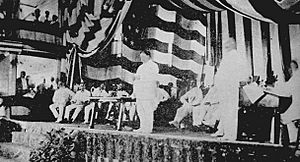
On March 3, 1901, the U.S. Congress passed the Army Appropriation Act containing (along with the Platt Amendment on Cuba) the Spooner Amendment which provided the president with legislative authority to establish of a civil government in the Philippines. Up until this time, the president had been administering the Philippines by virtue of his war powers. On July 1, 1901, civil government was inaugurated with William H. Taft as the civil governor. Later, on February 3, 1903, the U.S. Congress would change the title of Civil Governor to Governor-General.
A highly centralized public school system was installed in 1901, using English as the medium of instruction. This created a heavy shortage of teachers, and the Philippine Commission authorized the secretary of public instruction to bring to the Philippines 600 teachers from the U.S.—the so-called Thomasites. Free primary instruction that trained the people for the duties of citizenship and avocation was enforced by the Taft Commission per instructions of President McKinley. Also, the Catholic Church was disestablished, and a considerable amount of church land was purchased and redistributed.
An anti-sedition law was established in 1901, followed by an anti-brigandage law in 1902.
Official end of the war
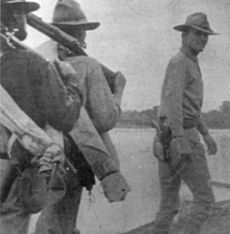
The Philippine Organic Act—approved on July 1, 1902—approved, ratified, and confirmed McKinley's previous executive order establishing the Second Philippine Commission. The act also stipulated that a bicameral legislature would be established composed of a popularly elected lower house, the Philippine Assembly, and an upper house consisting of the appointed Philippine Commission. The act also provided for extending the United States Bill of Rights to Filipinos. On July 2, the United States Secretary of War telegraphed that since the insurrection against the United States had ended and provincial civil governments had been established throughout most of the Philippine archipelago, the office of military governor was terminated. On July 4, Theodore Roosevelt, who had succeeded to the U.S. presidency after the assassination of President McKinley on September 5, 1901, proclaimed a full and complete pardon and amnesty to all persons in the Philippine archipelago who had participated in the conflict.
On April 9, 2002, Philippine President Gloria Macapagal Arroyo proclaimed that the Philippine–American War had ended on April 16, 1902, with the surrender of General Miguel Malvar. She declared the centennial anniversary of that date as a national working holiday and as a special non-working holiday in the province of Batangas and in the cities of Batangas, Lipa and Tanauan.
The Kiram-Bates Treaty secured the Sultanate of Sulu. American forces also established control over interior mountainous areas that had resisted Spanish conquest.
Casualties
Casualties during the war were much greater among Filipinos than among Americans. The United States Department of State states that the war "resulted in the death of over 4,200 American and over 20,000 Filipino combatants", and that "as many as 200,000 Filipino civilians died from violence, famine, and disease". The total number of Filipinos who died remains a matter of debate. Modern sources cite a figure of 200,000 total Filipino civilians dead, with most losses attributable to famine, and disease. A cholera epidemic at the war's end killed between 150,000 and 200,000 people.
Aftermath

Post-1902 conflicts
After military rule was terminated on July 4, 1902, the Philippine Constabulary was established as an archipelago-wide police force to control brigandage and deal with the remnants of the insurgent movement. The Philippine Constabulary gradually took over the responsibility for suppressing hostile forces' activities from United States Army units. Remnants of Aguinaldo's Republic, and remnants or holdovers of the Katipunan organization which had predated the American presence, and other resistance groups all remained active, fighting the United States military or Philippine Constabulary for nearly a decade after the official end of the war. After the close of the war, however, Governor General Taft preferred to rely on the Philippine Constabulary and to treat the "Irreconcilables" as a law enforcement concern rather than a military concern requiring the involvement of the American army. Thus the actions of these remaining guerrilla resistance movements were labeled as brigandage or banditry, and dismissed by the American government as bandits, fanatics and cattle rustlers.
In 1902, Macario Sakay established the Republika ng Katagalugan, claiming to succeed the First Philippine Republic, in Morong along Katipunan lines as opposed to Aguinaldo's Republic. This republic ended in 1906 when Sakay and his top followers surrendered upon being offered amnesty by the American authorities, but instead were arrested, and executed the following year.
Beginning in 1903, brigandage by organized groups became a problem in some of the outlying provinces in the Visayas. Among these groups were the Pulahan (Spanish: Pulajanes), who were from the highlands of Samar and Leyte. The term is derived from the native word pula, meaning "red", as they were distinguished by the red garments they wore. The Pulajanes subscribed to a blend of Roman Catholic and folk beliefs. For example, they believed certain amulets called agimat would render them bulletproof. The last of these groups were defeated or had surrendered to the Philippine Constabulary by 1911.
The American government had signed the Kiram-Bates Treaty with the Sultanate of Sulu at the outbreak of the war, that was supposed to prevent resistance in that part of the Philippines (which included parts of Mindanao, the Sulu Archipelago, Palawan and Sabah). However, after the Filipino resistance in Luzon and the Visayas collapsed, the United States canceled the treaty, and began to colonize Moro land, which provoked the Moro Rebellion, beginning with the Battle of Bayan in May 1902. In the First Battle of Bud Dajo in March 1906, 800-900 Moros were killed by US forces under the command of General Leonard Wood, an event which is also known as the Moro Crater Massacre. The rebellion continued until the Battle of Bud Bagsak in June 1913, in which Moro forces under Datu Amil were defeated by US troops led by General John J. Pershing. The battle marked the end of the Moro conflict; negotiations between the US authorities and Sulu Sultanate continued until the latter's dissolution in March 1915.
A 1907 law prohibited the display of flags and other symbols "used during the late insurrection in the Philippine Islands". Some historians consider these unofficial extensions to be part of the war.
Cultural impact
The influence of the Roman Catholic Church was reduced when the secular United States Government disestablished the Church and purchased and redistributed Church lands, one of the earliest attempts at land reform in the Philippines. The land amounted to 170,917 hectares (422,350 acres), for which the Church asked $12,086,438.11 in March 1903. The purchase was completed on December 22, 1903, at a sale price of $7,239,784.66. The land redistribution program was stipulated in at least three laws: the Philippine Organic Act, the Public Lands Act, and the Friar Lands Act. Section 10 of the Public Land Act limited purchases to a maximum of 16 hectares for an individual or 1024 hectares for a corporation or like association. Land was also offered for lease to landless farmers, at prices ranging from fifty centavos to one peso and fifty centavos per hectare per annum. Section 28 of the Public lands Act stipulated that lease contracts may run for a maximum period of 25 years, renewable for another 25 years.
In 1901 at least five hundred teachers (365 males and 165 females) arrived from the U.S. aboard the U.S. Army Transport Thomas. The name Thomasite was adopted for these teachers, who firmly established education as one of America's major contributions to the Philippines. Among the assignments given were Albay, Catanduanes, Camarines Norte, Camarines Sur, Sorsogon, and Masbate, which are the present day Bicol Region, which is also the region which was heavily resistant to American rule. Twenty-seven of the original Thomasites either died of tropical diseases or were murdered by Filipino rebels during their first 20 months of residence. Despite the hardships, the Thomasites persisted, teaching and building learning institutions that prepared students for their chosen professions or trades. They opened the Philippine Normal School (now Philippine Normal University) and the Philippine School of Arts and Trades (PSAT) in 1901 and reopened the Philippine Nautical School, established in 1839 by the Board of Commerce of Manila under Spain. By the end of 1904, primary courses were mostly taught by Filipinos under American supervision.
According to historian Daniel Immerwahr, the first 15 American officers to hold the office of Chief of Staff of the United States Army all served in the Philippine-American War. Several veterans of the war, including Douglas MacArthur, Chester W. Nimitz, and Walter Krueger were all senior commanders in the US campaign to liberate the Philippines from the Empire of Japan during World War II.
Philippine independence and sovereignty (1946)
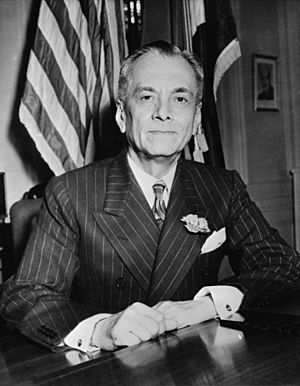
On January 20, 1899, President McKinley appointed the First Philippine Commission (the Schurman Commission), a five-person group headed by Dr. Jacob Schurman, president of Cornell University, to investigate conditions in the islands and make recommendations. In the report that they issued to the president the following year, the commissioners acknowledged Filipino aspirations for independence; they declared, however, that the Philippines was not ready for it. Specific recommendations included the establishment of civilian government as rapidly as possible (the American chief executive in the islands at that time was the military governor), including establishment of a bicameral legislature, autonomous governments on the provincial and municipal levels, and a new system of free public elementary schools.
From the very beginning, United States presidents and their representatives in the islands defined their colonial mission as tutelage: preparing the Philippines for eventual independence. Except for a small group of "retentionists", the issue was not whether the Philippines would be granted self-rule, but when and under what conditions. Thus political development in the islands was rapid and particularly impressive in light of the complete lack of representative institutions under the Spanish. The Philippine Organic Act of July 1902 stipulated that, with the achievement of peace, a legislature would be established composed of a lower house, the Philippine Assembly, which would be popularly elected, and an upper house consisting of the Philippine Commission, which was to be appointed by the president of the United States.
The Jones Act, passed by the U.S. Congress in 1916 to serve as the new organic law in the Philippines, promised eventual independence and instituted an elected Philippine senate. The Tydings–McDuffie Act (officially the Philippine Independence Act; Public Law 73–127) approved on March 24, 1934, provided for self-government of the Philippines and for Filipino independence (from the United States) after a period of ten years. World War II intervened, bringing the Japanese occupation between 1941 and 1945. In 1946, the Treaty of Manila between the governments of the U.S. and the Republic of the Philippines provided for the recognition of the independence of the Republic of the Philippines and the relinquishment of American sovereignty over the Philippine Islands.
See also
 In Spanish: Guerra filipino-estadounidense para niños
In Spanish: Guerra filipino-estadounidense para niños
- Campaigns of the Philippine–American War
- History of the Philippines (1898–1946)
- Philippines–United States relations
- Timeline of the Philippine–American War




